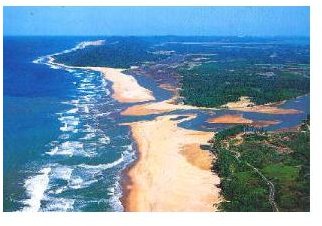Types of Aquatic Ecosystems: Marine and Freshwater Ecosystems with Examples
Aquatic Ecosystem Meaning
An ecosystem is an entity formed by the interaction between living organisms and the physical environment. It is classified into two main
categories: Terrestrial ecosystems and Aquatic ecosystems. Terrestrial ecosystems contain organisms that depend on physical environment on land masses of continents. Aquatic ecosystems are systems composed of living organisms and non-living elements interacting in a watery environment. In simple terms, an aquatic ecosystem is a community of plants and animals that primarily depend on water. There are two major types of aquatic ecosystems:
-
Marine Ecosystems
-
Freshwater Ecosystems
Marine Ecosystems
While terrestrial ecosystems cover only about 28 percent, marine ecosystems cover approximately 71 percent of the earth’s surface. Different habitats ranging from coral reefs to estuaries make up this largest aquatic ecosystem in the planet. Prime examples of marine ecosystems include:
-
Ocean: Main body of salty water that is further divided into important oceans and smaller seas. Major oceans include the Pacific Ocean, Indian Ocean, Arctic Ocean, Atlantic Ocean and Southern Ocean.
-
Intertidal zone: Area which remains underwater at high tide and remains terrestrial at low tide. Different types of habitats including wetlands, rocky cliffs and sandy beaches fall under intertidal zones.
-
Estuaries: Areas between river and ocean environments that are prone to tides and inflow of both freshwater and saline water. Due to this inflow, estuaries have high levels of nutrients. There are different names of estuaries such as inlets, lagoons, harbors etc.
-
Coral Reefs : Often referred as the “rainforests of the sea”, coral reefs are mounds found in marine waters as a result of accumulation of calcium carbonate deposited by marine organisms like corals and shellfish. Coral reefs form the most varied marine ecosystems in the planet, but cover less then one percent of the world’s ocean. Nevertheless, around 25 percent of marine animals including different types of fishes, sponges and mollusks are found in coral reefs.
Common species found in marine ecosystems include:
-
Marine mammals such as seals, whales and manatees
-
Different species of fish including mackerel, flounder, dogfish, sea bass, etc.
-
Organisms such as the tiny planktonic, brown algae corals, echinoderms, etc.
Marine ecosystems are important for the well-being of both terrestrial and aquatic environments. However, they are vulnerable to environmental problems such as climate change, pollution and overfishing, which can be a serious harm to marine biodiversity.
Freshwater Ecosystems
Although freshwater ecosystems are one of the main types of aquatic ecosystems, only 0.8 percent of the earth’s surface is covered by them. The water in freshwater ecosystems is non-saline (which means water has no salt content). Approximately 41 percent of the earth’s fishes are found in freshwater ecosystems.
Examples of freshwater ecosystems are:
-
Streams and rivers (Lotic): Lotic ecosystems refer to systems with rapid flowing waters that move in a unidirectional way. Best examples are rivers and streams, which harbor several species of insects and fishes. Crustaceans like crayfish and crabs; and mollusks such as clams and limpets are commonly found in streams and rivers. Various mammals such as beavers, otters and river dolphins also inhabit lotic ecosystems.
-
Lakes, ponds and pools (Lentic): Lentic ecosystems are still waters such as lakes and ponds that have a community of biotic (living organisms) and abiotic (physical objects) interactions. Ponds and lakes have a diverse variety of organisms including algae, rooted and floating-leaved plants, invertebrates such as crabs, shrimps, crayfish, clams etc, amphibians such as frogs and salamanders; and reptiles like alligators and water snakes.
-
Wetlands: The best examples of wetlands include swamps and marshes, where the water is completely or partially shallow. Biologically, wetlands are known to be too diverse as it harbors numerous animals and plant species. Plants such as black spruce, water lilies, mangrove, tamarack and sedges are commonly found in wetlands. Various species of reptiles and amphibians are also found in wetlands.
Freshwater ecosystems, which are one of the major types of aquatic ecosystems, are in danger because of the rapid extinction rates of several invertebrates and vertebrates, mainly because of overfishing and other activities that harm the ecosystem.
References
https://www.thewildclassroom.com/biomes/wetlands.html
https://www.britannica.com/EBchecked/topic/504928/riverine-ecosystem
https://www.rbnc.org/schoolunits/aquaeco.htm
https://www.epa.gov/bioiweb1/aquatic/marine.html
https://www.epa.gov/bioiweb1/aquatic/freshwater.html
https://www.grida.no/publications/rr/our-precious-coasts/page/1288.aspx
“Aquatic Ecosystems”, “Lotic, Lentic Ecosystems and Wetlands” Wikipedia
Image References:
An image of an estuary: https://en.wikipedia.org/wiki/File:Estuary-mouth.jpg
This post is part of the series: All About Ecosystems
In this series of articles, you will learn all about ecosystems-what they are, what types exist, and how they differ from one another.
